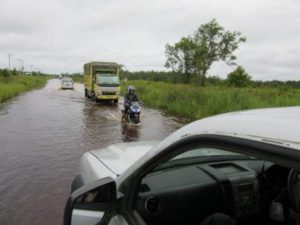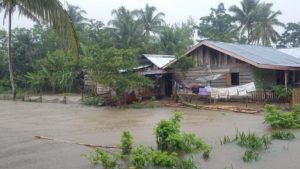
There is a lack of evidence of the effects of trees on reducing, or worsening, floods. Arguments continue about whether the research results that do exist from small-scale studies also apply at larger scales. A new technique is proving useful for finding evidence and better predicting trees’ role in flood mitigation.
Not surprisingly, humans have found the subject of floods of compelling interest, especially the extent to which removing trees from a watershed increases or decreases the risk of flooding. The pros and cons of deforestation have been hotly debated over the last 100 years and the basic concepts go back 2000 years.
The debate oscillates between strong over-generalizations — encapsulated in statements such as ‘forests are good for any aspect of water’ — to disbelief in anything not supported by strong evidence.
For CGIAR Research Program on Forests, Trees and Agroforestry (FTA) scientist Meine van Noordwijk of the World Agroforestry Centre (ICRAF), the challenge in the debate is properly understanding things at scale. Does deforestation increase the risk of flooding from small to large scales — and even can any flood be attributed to removing or adding trees — or is the evidence primarily valid only at the scale of measurement and not necessarily beyond?
For example, can the results of research in a small catchment be applied across a much larger landscape and help to decide whether more or less trees are needed to reduce flooding, or whether they have any effect at all?
Watch: Play it cool with symposium recordings
A new article in the journal, Hydrology and Earth System Science, explores the middle ground in the debate and offers scientists an easier way of predicting river flow from rainfall and, consequently, the likelihood of flooding.
In the articles, Flood risk reduction and flow buffering as ecosystem services: I. Theory on flow persistence, flashiness and base flow; II. Land use and rainfall intensity effects in Southeast Asia, a team of authors from the World Agroforestry Centre and Wageningen University explain that a new ‘flow persistence’ metric matches local knowledge on watershed degradation as leading to loss of predictability of flow.

It is correlated with two metrics that have been used before: a ‘flashiness’ index as indicator of catchment health; and a ‘base flow’ metric that represents the opposite aspect of continued flow in dry periods. The empirical relationship between these two metrics depends on the context: terrain and details of rainfall patterns. The flow persistence metric can be derived from any period of consistent river flow measurements.
Of course, the more data, the more accurate the estimates will be but data requirements are much less than for the models that have been used so far. This is a good step in the right direction for better understanding how catchments work and how flooding can be reduced.
“Good quality data on river flow is scarce for many tropical watersheds,” said Van Noordwijk, lead author of the study, “so we need to first of all rely on consistency of interpretation and robust indicators of ‘buffering’ as the key process linking floods to rainfall. What we presented is a simple metric called ‘flow persistence’. Where its value is high, it means that only a small fraction of peak rainfall comes to the river the same day; when it is low, peak river flow will be high but will rapidly decline after that.”
Co-author Betha Lusiana, who heads ICRAF’s ecological modelling unit in Indonesia, explained that, “When we applied this method to cases in Southeast Asia, we found that annual variations in rainfall are such that effects of land cover on river flow in anything other than a small catchment can only be asserted statistically with long-term data. Lack of evidence of effects is not the same as evidence of lack of effects, as Sherlock Holmes already noted.”

There is a lot of interest in “restoration”, but we need metrics of where it is most relevant. The Flow Persistence method makes it easier for scientists to gather and analyse data extrapolate it across whole landscapes. This improves the ability to predict effect on river flow, and the potential for flooding, if trees in the form of agroforests are put back into large-scale, deforested landscapes.
This, too, is an area of research which hasn’t been fully studied at large scale yet such knowledge is in increasing demand to meet the needs of the various global programs aimed at rehabilitating the many millions of hectares of degraded landscapes.
“When forests are removed and the land is used for agriculture or other purposes, we observed that the flow persistence decreases when the soils no longer absorb all the rain,” explained Lisa Tanika, who is ICRAF’s hydrologist in Indonesia, “whereas agroforestation, which returns trees to the landscape, can induce a restoration of hydrological functions but it will take 5-to-10 years to see the effects.”
Being able to predict more accurately the restoration of such functions that are provided by different combinations of tree species in landscapes increasingly stressed by extremes of climate will increase the efficiency and effectiveness of rehabilitation programs.
The findings come at an appropriate time, following on from a recent, ground-breaking symposium that brought to the world’s attention the importance of forests and agroforests in the production of atmospheric moisture, a role second only to the world’s oceans in the global water cycle.
Read more:
- Trees, water and climate: Cool scientific insights, hot implications for research and policy
- Connecting the dots between forests, water and climate
“Rather than think of trees only as things that soak up carbon and reduce the harmful effects of greenhouse gases, which is how international bodies like the United Nations Framework Convention on Climate Change see them,” argued Van Noordwijk, who was a key presenter at the symposium.
“We need to shift the focus to their role in the water cycle, something especially important for an increasingly hot and dry world. The Flow Persistence metric is a small but important part of such a shift.”
By Rob Finlayson, originally published at ICRAF’s Agroforestry World.
This research forms part of the CGIAR Research Program on Forests, Trees and Agroforestry.
We would like to thank all donors who supported this research through their contributions to the CGIAR Fund.











